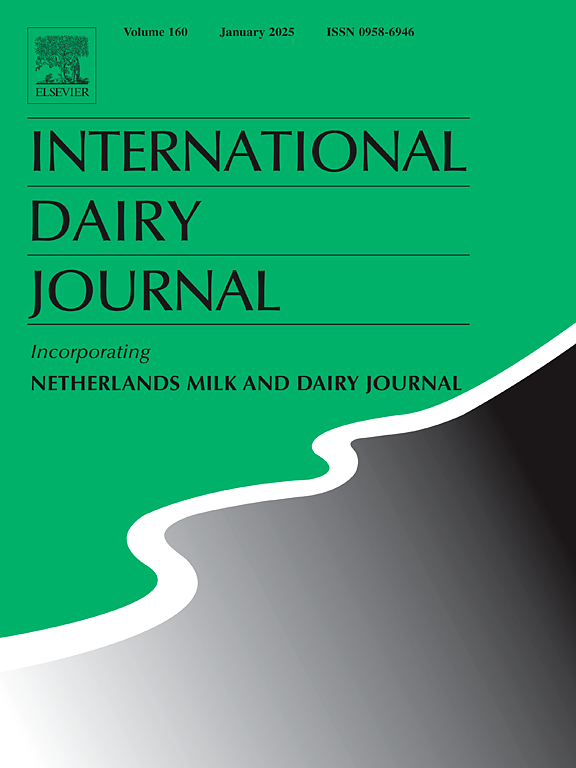HTST和UV-C处理对全脂牛奶、脱脂牛奶和乳清浓缩蛋白品质属性的影响
IF 3.4
3区 农林科学
Q2 FOOD SCIENCE & TECHNOLOGY
引用次数: 0
摘要
紫外线(UV-C)处理是传统的高温短时间(HTST)牛奶巴氏杀菌工艺的替代方案。然而,关于它对牛奶化学成分的影响以及与HTST处理的比较的信息很少。因此,本研究的目的是比较HTST(72°C, 16 s)和UV-C(线圈直径为5和7毫米,1或2次)在湍流下对全脂牛奶(WM)、脱脂牛奶(SM)、由全脂牛奶生成的脱脂牛奶(SMWM)和乳清浓缩蛋白(WPC)的近似组成、蛋白质谱和表面特性以及异味发展的影响。我们对近似成分的研究结果表明,与HTST相比,只有使用7毫米线圈进行2次UV-C处理才能使SMWM中的脂质含量降低。蛋白质谱、游离硫醇含量、表面疏水性和芳香氨基酸水平在对照、HTST和UV-C处理的样品之间保持相似。然而,hst处理的样品中检测到较高的酒精含量,而uv - c处理的乳制品液体中游离脂肪酸和酮的含量增加。此外,己醛浓度仅在经HTST处理后才升高。这项研究强调了UV-C处理在乳制品行业的潜力,证明了其保持营养质量的能力,同时也为脂质氧化和光诱导的异味化合物的形成提供了有价值的见解。本文章由计算机程序翻译,如有差异,请以英文原文为准。
Comparison of HTST and UV-C treatments on the quality attributes of whole milk, skim milk, and whey protein concentrate
Ultraviolet (UV-C) treatment is a proposed alternative to conventional high temperature-short time (HTST) processes for milk pasteurization. However, little information is available on its impact on the chemical composition of milk, as well as a comparison with HTST treatment. Consequently, the aim of this study was to compare the effects of HTST (72 °C, 16 s) and UV-C (coil diameters of 5- and 7-mm, 1 or 2 passes) with turbulent flow on the proximate composition, protein profiles and surface properties, as well as off-flavor development in whole milk (WM), skim milk (SM), skim milk generated from whole milk (SMWM), and whey protein concentrate (WPC). Our results on proximate composition showed that only the UV-C treatment with 2 passes using a 7-mm coil resulted in lower lipid content in SMWM compared to HTST. Protein profiles, free thiol content, surface hydrophobicity, and aromatic amino acid levels remained similar between the control, HTST and UV-C treated samples. However, higher alcohol levels were detected in HTST-treated samples, while UV-C-treated dairy fluids had increased levels of free fatty acids and ketones. In addition, hexanal concentration increased only after HTST treatment of WM. This study highlights the potential of UV-C treatment in the dairy industry, demonstrating its ability to preserve nutritional quality while also offering valuable insights into lipid oxidation and the formation of light-induced off-flavor compounds.
求助全文
通过发布文献求助,成功后即可免费获取论文全文。
去求助
来源期刊

International Dairy Journal
工程技术-食品科技
CiteScore
6.50
自引率
9.70%
发文量
200
审稿时长
49 days
期刊介绍:
The International Dairy Journal publishes significant advancements in dairy science and technology in the form of research articles and critical reviews that are of relevance to the broader international dairy community. Within this scope, research on the science and technology of milk and dairy products and the nutritional and health aspects of dairy foods are included; the journal pays particular attention to applied research and its interface with the dairy industry.
The journal''s coverage includes the following, where directly applicable to dairy science and technology:
• Chemistry and physico-chemical properties of milk constituents
• Microbiology, food safety, enzymology, biotechnology
• Processing and engineering
• Emulsion science, food structure, and texture
• Raw material quality and effect on relevant products
• Flavour and off-flavour development
• Technological functionality and applications of dairy ingredients
• Sensory and consumer sciences
• Nutrition and substantiation of human health implications of milk components or dairy products
International Dairy Journal does not publish papers related to milk production, animal health and other aspects of on-farm milk production unless there is a clear relationship to dairy technology, human health or final product quality.
 求助内容:
求助内容: 应助结果提醒方式:
应助结果提醒方式:


